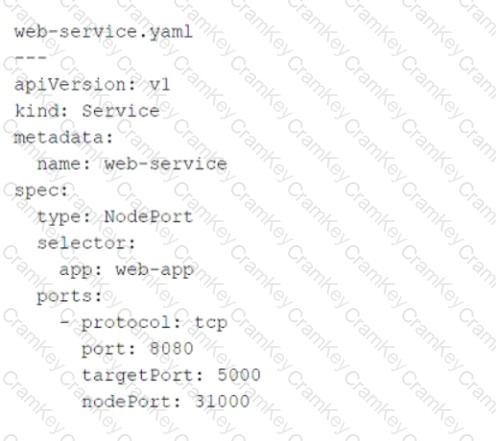The YAML file provided in the exhibit defines a KubernetesServiceobject of typeNodePort. Let’s break down the key components of the configuration and analyze how external users access the WEB application:
Key Fields in the YAML File:
type: NodePort:
This specifies that the service is exposed on a static port on each node in the cluster. External users can access the service using the node's IP address and the assignednodePort.
port: 8080:
This is the port on which the service is exposed internally within the Kubernetes cluster. Other services or pods within the cluster can communicate with this service using port8080.
targetPort: 5000:
This is the port on which the actual application (WEB application) is running inside the pod. The service forwards traffic fromport: 8080totargetPort: 5000.
nodePort: 31000:
This is the port on the node (host machine) where the service is exposed externally. External users will use this port to access the WEB application.
How External Users Access the WEB Application:
External users access the WEB application using the node's IP address and thenodePortvalue (31000).
The Kubernetes service listens on this port and forwards incoming traffic to the appropriate pods running the WEB application.
Why Not Other Options?
A. 80:Port80is commonly used for HTTP traffic, but it is not specified in the YAML file. The service does not expose port80externally.
B. 8080:Port8080is the internal port used within the Kubernetes cluster. It is not the port exposed to external users.
D. 5000:Port5000is the target port where the application runs inside the pod. It is not directly accessible to external users.
Why 31000?
NodePort Service Type:TheNodePortservice type exposes the application on a high-numbered port (default range: 30000–32767) on each node in the cluster.
External Accessibility:External users must use thenodePortvalue (31000) along with the node's IP address to access the WEB application.
JNCIA Cloud References:
The JNCIA-Cloud certification covers Kubernetes networking concepts, including service types likeClusterIP,NodePort, andLoadBalancer. Understanding howNodePortservices work is essential for exposing applications to external users in Kubernetes environments.
For example, Juniper Contrail integrates with Kubernetes to provide advanced networking features, such as load balancing and network segmentation, for services like the one described in the exhibit.
[Reference:, Kubernetes Documentation: Service Types, Juniper JNCIA-Cloud Study Guide: Kubernetes Networking, , ]
